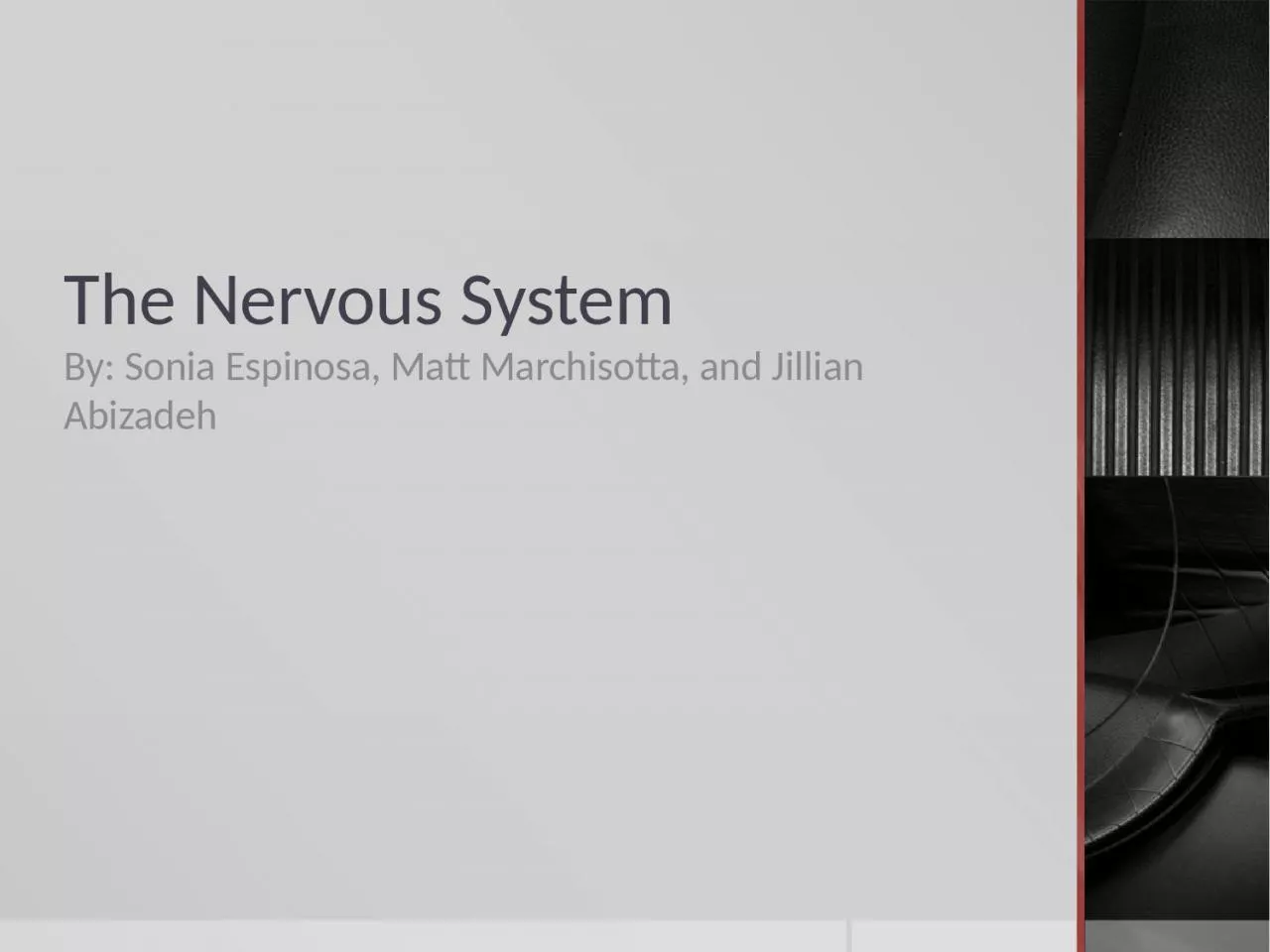

Marchisotta and Jillian Abizadeh The Nervous Systems Main Function Your bodys control system it sends receives and processes nerve impulses all throughout the body The nervous system is comprised of nerves made up of specialized cells known as ID: 1038740
Download Presentation The PPT/PDF document "The Nervous System By: Sonia Espinosa, M..." is the property of its rightful owner. Permission is granted to download and print the materials on this web site for personal, non-commercial use only, and to display it on your personal computer provided you do not modify the materials and that you retain all copyright notices contained in the materials. By downloading content from our website, you accept the terms of this agreement.
1. The Nervous SystemBy: Sonia Espinosa, Matt Marchisotta, and Jillian Abizadeh
2. The Nervous System’s Main Function Your body’s control system, it sends, receives, and processes nerve impulses all throughout the bodyThe nervous system is comprised of nerves made up of specialized cells known as neuronsThe nervous system is essential when it comes to perceiving and comprehending the external world
3. Where is the nervous system in your body?...everywhere!
4. Main parts of the System and vocabularyBrain- An organ of soft nervous tissue contained in the skull of vertebrates, functioning as the coordinating center of sensation and intellectual and nervous activityCerebrum- The principal and most anterior part of the brain in vertebratesCerebellum- The part of the brain at the back of the skull in vertebrates, it also coordinates and regulates muscular activityMedulla- The inner region of an organ or tissue, especially when it is distinguishable from the outer region or cortex Spinal Cord- The cylindrical bundle of nerve fibers and associated tissue that is enclosed in the spine and connects nearly all parts of the body to the brainNerves- A whitish fiber or bundle of fibers that transmits impulses of sensation to the brain or spinal cord, and impulses from these to the muscles and organsNeurons- A specialized cell transmitting nerve impulsesImpulses- A sudden strong and unreflective urge or desire to actNeurotransmitter- A chemical substance that is released at the end of a nerve fiber by the arrival of a nerve impulse and, by diffusing across the synapse or junctionReflexes- An action that is performed as a response to a stimulus and without conscious thoughtStimulus- a thing or event that evokes a specific functional reaction in an organ or tissueResponse- an behavior of a living organism that results from an external or internal stimulus
5. Some pictures to brighten your day!
6. ….and more!
7. What each part does:Central nervous system- consists of the brain and spinal cord, sends out nerve impulses and analyzes information from the sense organs, it is the main control center in your body, and the center of thought.Peripheral nervous system- includes the craniospinal nerves that branch off from the brain and spinal cord; from the central nervous system, it carries nerve impulses to the muscles and glands Autonomic nervous system- regulates involuntary action, such as a heart beat and digestion.
8.
9. Never seen a brain?! Well now ya have!
10. Describe the path a nerve impulse travels throughout the body from stimulus to responseThey pass through the thoracic region to innervate the internal organs
11. How the system affects other body systemsReceptors in muscles provide the brain with information about body position and movement. The brain controls the contraction of skeletal muscle. The nervous system regulates the speed at which food moves through the digestive tract.
12. How other body systems affect the systemBones from the skeletal system provide calcium that is essential for the proper functioning of the nervous system. In the endocrine system, reproductive hormones affect the development of the nervous system.The digestive system sends sensory information to the brain. Reproductive hormones from the reproductive system affect brain development and sexual behavior.
13.
14. Two diseases of the nervous systemEpilepsy, in which abnormal electrical discharges from brain cells can seize which means they can cause seizures, epilepsy is triggered by bright and or flashing lights. That is why there are caution signs in movies or television shows that have bright and or flashing lightsHuntington’s disease, which is an inherited condition that causes the nerve cells in the brain to degenerate.
15. Effects of outside/environmental factors on the systemLead in the nervous system causes…Kidney damageLearning disabilitiesAttention deficit disorderDecreased intelligence
16. Fun Facts!There are millions of nerve cells in the human body. This number even exceeds the number of stars in the Milky Way.The human brain consists of about 100 billion neurons. If all these neurons were to be lined up, it would form a 600 mile long line. In humans, the right side of the brain controls the left side of the body, while the left side of the brain controls the right side.
17. Resources http://artdistrictchiropractic.com/new-patient-center/fun-facts.htmlhttp://www.livescience.com/22665-nervous-system.htmlhttps://www.merriam-webster.com/dictionary/brainhttps://faculty.washington.edu/chudler/organ.htmlhttp://serendip.brynmawr.edu/bb/neuro/neuro00/web2/Patel.htmlhttp://kidshealth.org/en/kids/brain.htmlhttp://www.healthline.com/human-body-maps/medulla-oblongatahttps://www.uab.edu/medicine/sci/faqs-about-spinal-cord-injury-sci/what-does-the-spinal-cord-dohttps://www.reference.com/science/nerves-5c6f4991b82d6b73http://www.brainfacts.org/brain-basics/neuroanatomy/articles/2012/the-neuron/